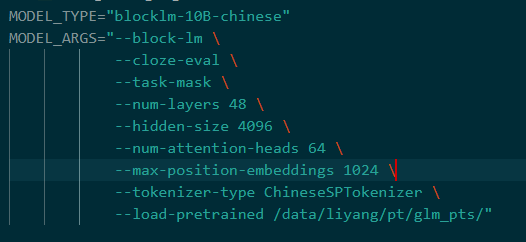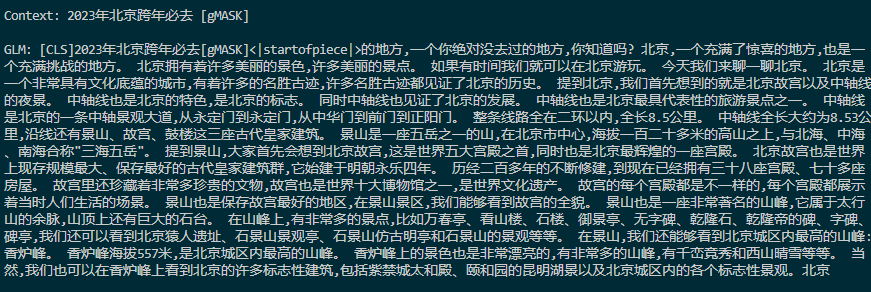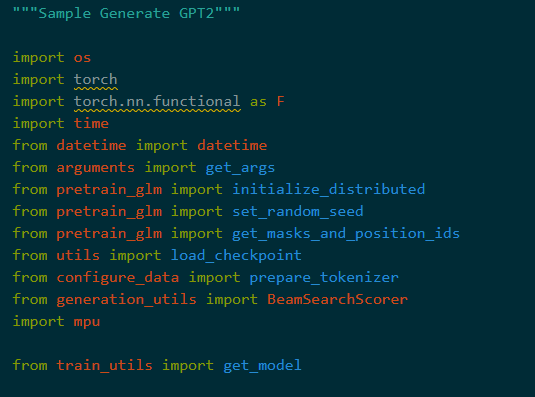CC BY 4.0 (除特别声明或转载文章外)
如果这篇博客帮助到你,可以请我喝一杯咖啡~
深入理解GLM运作机制
先熟悉熟悉glm的代码吧,包括数据读取,模型结构,解码方式 理论部分见前面博客写的GLM论文解析
背景
官方网址 首先GLM是一个自回归模型 先下载预训练权重 官方共提供 10个(不包含千亿模型)
- GLM-Base 110M
- GLM-Large 335M
- GLM-Large-Chinese 335M
- GLM-Doc 335M
- GLM-410M
- GLM-515M
- GLM-RoBERTa 335M
- GLM-2B
- GLM-10B
- GLM-10B-Chinese
关于环境后期补一个关于Docker的说明emmmm (先鸽了)
使用
在huggingFace快速体验 huggingface使用教程后期补 (先鸽了)
生成
from transformers import AutoTokenizer, AutoModelForSeq2SeqLM
tokenizer = AutoTokenizer.from_pretrained("BAAI/glm-10b", trust_remote_code=True)
model = AutoModelForSeq2SeqLM.from_pretrained("BAAI/glm-10b", trust_remote_code=True)
model = model.half().cuda()
model.eval()
# 推理
inputs = tokenizer("Ng is an adjunct professor at [MASK] (formerly associate professor and Director of its Stanford AI Lab or SAIL ). Also a pioneer in online education, Ng co-founded Coursera and deeplearning.ai.", return_tensors="pt")
inputs = tokenizer.build_inputs_for_generation(inputs, max_gen_length=512)
inputs = inputs.to('cuda')
outputs = model.generate(**inputs, max_length=512, eos_token_id=tokenizer.eop_token_id)
print(tokenizer.decode(outputs[0].tolist()))
# 训练
inputs = tokenizer(
["Tsinghua University is located in [MASK].", "One minus one equals zero, is it correct? Answer: [MASK]"],
return_tensors="pt", padding=True)
inputs = tokenizer.build_inputs_for_generation(inputs, targets=["Beijing", "No"], max_gen_length=8)
inputs = inputs.to('cuda')
outputs = model(**inputs)
loss = outputs.loss
logits = outputs.logits
分类
from transformers import AutoTokenizer, AutoModelForMultipleChoice
tokenizer = AutoTokenizer.from_pretrained("BAAI/glm-10b", trust_remote_code=True)
model = AutoModelForMultipleChoice.from_pretrained("BAAI/glm-10b", trust_remote_code=True)
model = model.half().cuda()
model.eval()
inputs = tokenizer(["Tsinghua University is located in [MASK].",
"One minus one equals zero, is it correct? Answer: [MASK]"], return_tensors="pt", padding=True)
choices = [["Beijing", "Shanghai"], ["Yes", "No"]]
inputs = tokenizer.build_inputs_for_multiple_choice(inputs, choices)
inputs = inputs.to('cuda')
outputs = model(**inputs)
logits = outputs.logits
官方提供了脚本供微调代码以适应下游任务
从左到右的生成 /空白填充(交互式)
改变CHECKPOINT_PATH
bash scripts/generate_block.sh \
config_tasks/model_blocklm_10B_chinese.sh
不同模型使用不同的MASK token
[MASK] 短文本填充
[sMASK] 句子填充
` [gMASK] 自左到右生成
每个空白答案以<|startofpiece|>`开始
SuperGLUE
修改DATA_ROOT, CHECKPOINT_PATH, SAVE_PATH
同时需要根据自身硬件修改bs和nproc_per_node
以COPA数据集为例
bash scripts/ds_finetune_superglue.sh \
config_tasks/model_blocklm_10B.sh \
config_tasks/task_copa.sh
- P-tuning
bash scripts/ds_finetune_superglue_prompt.sh \
config_tasks/model_blocklm_10B.sh \
config_tasks/task_copa.sh
- 去应用GLM在新的NLU数据集(冻结微调)执行
DataProcessortasks/superglue/dataset.py载入数据,加入PVPtasks/superglue/pvp.py锁定问题
S2S任务
修改DATA_ROOT, CHECKPOINT_PATH, SAVE_PATH
使用CNN/Daily数据集为例
bash scripts/ds_finetune_seq2seq.sh \
config_tasks/model_blocklm_10B.sh \
config_tasks/seq_cnndm_org.sh
摘要写入./runs/experiment_name/test.jsonl.hyps
参考写入test.jsonl.refs
如果要计算rouge,安装file2rouge并下载 Stanford CoreNLP。
bash scripts/evaluate_seq2seq.sh \
./runs/experiment_name/test.jsonl.hyps ./runs/experiment_name/test.jsonl.refs
训练自己的数据
加载你自己的数据在{split}.source和{split}.target
每一行是一个内容,划分为train,val和test
bash scripts/ds_finetune_seq2seq.sh \
config_tasks/model_blocklm_10B.sh \
config_tasks/seq_customization.sh
在config_tasks/seq_customization.sh和config_tasks/config_blocklm_10B_cnndm.json中确认超参数
多项选择(Zero-shot)
修改CHECKPOINT_PATH和DATA_PATH
bash scripts/evaluate_multichoice.sh config_tasks/model_blocklm_10B.sh
数据文件格式应该像下面所示
{"inputs_pretokenized": "Context and question here", "choices_pretokenized": ["Choice 1", "Choice 2", "Choice 3"], "label": int}
语言模型
- LAMBADA完型填空精度
下载LAMBADA数据,修改DATA_ROOT, CHECKPOINT_PATH在scripts/evaluate_lm.sh
bash scripts/evaluate_lm.sh \
config_tasks/model_blocklm_large_generation.sh \
config_tasks/zero_lambada.sh
- LM Perplexity
下载 test set of wikibook 或者 Wikitext103数据集,修改DATA_ROOT, CHECKPOINT_PATH在scripts/evaluate_lm.sh
bash scripts/evaluate_lm.sh \
config_tasks/model_blocklm_large_generation.sh \
config_tasks/zero_wikitext.sh
文本填空
- 下载Yahoo数据集,修改
DATA_ROOT, CHECKPOINT_PATH, SAVE_PATH
bash scripts/finetune_blank.sh \
config_tasks/model_blocklm_large.sh \
config_tasks/seq_blank.sh
预训练
bash scripts/ds_pretrain_nvidia.sh config/ds_block_large.sh
- scripts/ds_pretrain_nvidia.sh
修改NUM_WORKERS和NUM_GPUS_PER_WORKER.
同时修改HOST_FILE_PATH(OpenMPI-style hostfile)
后面更一期DeepSpeed使用说明emmmm (先鸽了)
- config/ds_block_large.sh
定义了超参数
--train-data可以在NAMED_CORPORA(data_utils/corpora.py)多关键词定义。
超参优化器在相应的config文件下(json)
数据读取(模型结构,解码方式)
从源码角度理解
官方简单填空生成角度(这部分主要是推理不涉及训练)
该样例没有用到deepspeed。简单的DDP启动 首先有两个脚本文件
- generate_block.sh
这里设置任务相关参数
- 使用显卡
- 模型权重路径(cp点)
- MPSIZE
- MAXSEQLEN
- MASTER_PORT
- TEMP
- TOPK
- TOPP
- config_json
-
model_blocklm_10B_chinese.sh 这里设置模型相关参数

懒得解释了,基本就是模型层数,编码,加载路径之类的。
- 核心执行文件generate_samples.py 先放段10B加载例子

这是个交互模型,简单来说没有太多应用级别的封装。 下面看源码 这种最简单的实例引用的包就比较贴近纯原生pytorch

除去主函数一共六个功能函数
- def setup_model(args) ——按pytorch官方教程重写
- def get_batch(context_tokens, device, args): ——按pytorch官方教程重写
- def top_k_logits(logits, top_k=0, top_p=0.0, filter_value=-float(‘Inf’)):
- def sample_sequence(model, tokenizer, context_tokens, context_length, args, device, mems=None, end_tokens=None):
- def read_context(tokenizer, args, output):
- def read_context(tokenizer, args, output):
- def generate_samples(model, tokenizer, args, device):
先从主函数代码解析
def main():
"""Main training program."""
print('Generate Samples')
# Disable CuDNN.禁用CuDNN
torch.backends.cudnn.enabled = False
# Arguments.获取参数
args = get_args()
args.mem_length = args.seq_length + args.mem_length - 1
# Pytorch distributed.分布式初始化
initialize_distributed(args)
# Random seeds for reproducability.设置随机种子
set_random_seed(args.seed)
# get the tokenizer设置tokenizer编码器
tokenizer = prepare_tokenizer(args)
# Model, optimizer, and learning rate.设置模型,优化器,学习率
model = setup_model(args)
# setting default batch size to 1 默认bs=1,一般训练会开的很大。
args.batch_size = 1
# generate samples采样
generate_samples(model, tokenizer, args, torch.cuda.current_device())
补充了一下中文注释,我觉得英文基本上说的很清楚每一步
核心要点看采样函数,其他模型大差不差。
采样函数
model.eval()
output_path = "./samples"
if not os.path.exists(output_path):
os.makedirs(output_path)
output_path = os.path.join(output_path, f"sample-{datetime.now().strftime('%m-%d-%H-%M')}.txt")
with torch.no_grad(), open(output_path, "w") as output:
while True:
torch.distributed.barrier(group=mpu.get_model_parallel_group())
terminate_runs, raw_text, context_tokens_tensor, context_length = read_context(tokenizer, args, output)
if terminate_runs == 1:
return
start_time = time.time()
if args.block_lm:
mems = []
tokens, attention_mask, position_ids = get_batch(context_tokens_tensor, device, args)
mask_tokens = ['MASK', 'sMASK', 'gMASK'] if args.task_mask else ['MASK']
mask_tokens = [tokenizer.get_command(token).Id for token in mask_tokens]
end_tokens = [tokenizer.get_command('eop').Id, args.eod_token]
mask_positions = []
for token in mask_tokens:
mask_positions += (context_tokens_tensor == token).nonzero(as_tuple=True)[0].tolist()
mask_positions.sort()
if args.no_block_position:
for mask_position in mask_positions:
position_ids[0, mask_position + 1:] += args.out_seq_length
_, *mems = model(tokens, position_ids, attention_mask, *mems)
for mask_position in mask_positions:
if args.no_block_position:
position = position_ids[0, mask_position].item()
else:
position = mask_position
tokens, mems = sample_sequence(model, tokenizer, tokens, position,
args, device, mems=mems, end_tokens=end_tokens)
else:
tokens, _ = sample_sequence(model, tokenizer, context_tokens_tensor, context_length, args, device)
output_tokens_list = tokens.view(-1).contiguous()
if mpu.get_model_parallel_rank() == 0:
os.system('clear')
print("\nTaken time {:.2f}\n".format(time.time() - start_time), flush=True)
print("\nContext:", raw_text, flush=True)
decode_tokens = tokenizer.DecodeIds(output_tokens_list.tolist())
trim_decode_tokens = decode_tokens
print("\nGLM:", trim_decode_tokens, flush=True)
output.write(trim_decode_tokens + "\n")
torch.distributed.barrier(group=mpu.get_model_parallel_group())
解析 核心实在time()函数后面,前面基本正常推理代码。 引入mems储存前一步attention,减少计算 通过get_batch()获得tokens,attention_mask,position_ids(pytorch 官方教程) 设置mask_token和end_token 计算mask_positions并排序 采样序列计算token
读入函数
def read_context(tokenizer, args, output):
terminate_runs, skip_run = 0, 0
if mpu.get_model_parallel_rank() == 0:
while True:
raw_text = input("\nContext prompt (stop to exit) >>> ")
if not raw_text:
print('Prompt should not be empty!')
continue
if raw_text == "stop":
terminate_runs = 1
break
generation_mask = '[gMASK]' if args.task_mask else '[MASK]'
if args.block_lm and 'MASK]' not in raw_text:
raw_text += ' ' + generation_mask
output.write(raw_text)
context_tokens = tokenizer.EncodeAsIds(raw_text).tokenization
if args.block_lm:
context_tokens = [tokenizer.get_command('ENC').Id] + context_tokens
if not raw_text.endswith('[gMASK]'):
context_tokens = context_tokens + [tokenizer.get_command('eos').Id]
context_length = len(context_tokens)
if context_length >= args.seq_length:
print("\nContext length", context_length,
"\nPlease give smaller context than the window length!")
continue
break
else:
context_length = 0
terminate_runs_tensor = torch.cuda.LongTensor([terminate_runs])
torch.distributed.broadcast(terminate_runs_tensor, mpu.get_model_parallel_src_rank(),
group=mpu.get_model_parallel_group())
terminate_runs = terminate_runs_tensor[0].item()
if terminate_runs == 1:
return terminate_runs, None, None, None
context_length_tensor = torch.cuda.LongTensor([context_length])
torch.distributed.broadcast(context_length_tensor, mpu.get_model_parallel_src_rank(),
group=mpu.get_model_parallel_group())
context_length = context_length_tensor[0].item()
if mpu.get_model_parallel_rank() == 0:
context_tokens_tensor = torch.cuda.LongTensor(context_tokens)
else:
context_tokens_tensor = torch.cuda.LongTensor([0] * context_length)
torch.distributed.broadcast(context_tokens_tensor, mpu.get_model_parallel_src_rank(),
group=mpu.get_model_parallel_group())
if mpu.get_model_parallel_rank() != 0:
raw_text = tokenizer.DecodeIds(context_tokens_tensor.tolist())
return terminate_runs, raw_text, context_tokens_tensor, context_length
- 输入tokerizer,参数,文件
- 输出
- terminate_runs
1表示停止 - raw_text 最终输入解码文本
- context_tokens_tensor 编码文本token
- context_length 编码文本token长度
- terminate_runs
主要对纯input输入增加了MASK]同时增加了判别保护机制
-
编码 tokenizer.EncodeAsIds(raw_text).tokenization
-
解码 tokenizer.DecodeIds(context_tokens_tensor.tolist())
序列采样
def sample_sequence(model, tokenizer, context_tokens, context_length, args, device, mems=None, end_tokens=None):
if not args.block_lm:
context_tokens, attention_mask, position_ids = get_batch(context_tokens, device, args)
tokens = torch.empty((args.num_beams, 0), device=context_tokens.device, dtype=torch.long)
else:
tokens = context_tokens.new_full((1, 1), tokenizer.get_command('sop').Id)
counter = 0
if mems is None:
mems = []
if end_tokens is None:
end_tokens = [args.eod_token]
if args.num_beams > 1:
beam_scorer = BeamSearchScorer(
batch_size=1,
max_length=args.out_seq_length,
num_beams=args.num_beams,
device=context_tokens.device,
length_penalty=args.length_penalty,
do_early_stopping=False,
)
beam_scores = torch.zeros(1, dtype=torch.float, device=context_tokens.device)
last_beam_num = 1
while counter < args.out_seq_length:
if counter == 0 and not args.block_lm:
next_token_logits, *mems = model(context_tokens, position_ids, attention_mask, *mems)
else:
if args.block_lm:
if args.no_block_position:
position_ids = context_tokens.new_full((last_beam_num, 1), context_length + counter)
else:
position_ids = context_tokens.new_ones(last_beam_num, 2, 1)
position_ids[:, 0] = context_length
position_ids[:, 1] = counter + 1
attention_mask = context_tokens.new_zeros([1], device=context_tokens.device, dtype=torch.long)
else:
position_ids = context_tokens.new_ones((last_beam_num, 1)) * (context_length + counter - 1)
attention_mask = context_tokens.new_ones(last_beam_num, 1, 1, args.mem_length + 1,
device=context_tokens.device, dtype=torch.float)
last_token = tokens[:, -1:]
next_token_logits, *mems = model(last_token, position_ids, attention_mask, *mems)
next_token_logits = next_token_logits[:, -1]
if args.num_beams > 1:
next_token_scores = F.log_softmax(next_token_logits, dim=-1)
next_token_scores = next_token_scores + beam_scores[:, None].expand_as(next_token_scores)
vocab_size = next_token_scores.shape[-1]
next_token_scores = next_token_scores.view(1, last_beam_num * vocab_size)
probs = F.softmax(next_token_scores, dim=-1)
next_tokens = torch.multinomial(probs, num_samples=2 * args.num_beams)
next_token_scores = torch.gather(next_token_scores, -1, next_tokens)
next_token_scores, _indices = torch.sort(next_token_scores, descending=True, dim=1)
next_tokens = torch.gather(next_tokens, -1, _indices)
next_indices = next_tokens // vocab_size
next_tokens = next_tokens % vocab_size
# stateless
tokens = tokens.expand((args.num_beams, -1))
beam_outputs = beam_scorer.process(
tokens,
next_token_scores,
next_tokens,
next_indices,
eos_token_id=end_tokens,
mems=mems
)
beam_scores = beam_outputs["next_beam_scores"]
beam_next_tokens = beam_outputs["next_beam_tokens"]
beam_idx = beam_outputs["next_beam_indices"]
beam_next_tokens = beam_next_tokens.unsqueeze(-1)
tokens = torch.cat([tokens[beam_idx, :], beam_next_tokens], dim=-1)
mems = [mem[beam_idx] for mem in mems] if mems else None
if beam_scorer.is_done:
break
last_beam_num = args.num_beams
else:
next_token_logits /= args.temperature
next_token_logits = top_k_logits(next_token_logits, top_k=args.top_k, top_p=args.top_p)
log_probs = F.softmax(next_token_logits, dim=-1)
prev = torch.multinomial(log_probs, num_samples=1)[0]
is_end = prev.item() in end_tokens
if is_end:
break
prev = prev.view(1, 1)
tokens = prev if tokens is None else torch.cat((tokens, prev), dim=1)
counter += 1
if not args.block_lm and mpu.get_model_parallel_rank() == 0 and counter % 16 == 0:
output_tokens_list = tokens.view(-1).contiguous()
decode_tokens = tokenizer.DecodeIds(output_tokens_list.tolist())
if mpu.get_model_parallel_rank() == 0 and (counter % 128 == 0 or is_end):
os.system('clear')
trim_decode_tokens = decode_tokens
print(trim_decode_tokens, flush=True)
if args.num_beams > 1:
tokens, mems, _ = beam_scorer.finalize(tokens, beam_scores, next_tokens, next_indices, eos_token_id=args.eod_token,
mems=mems)
return torch.cat((context_tokens, tokens), dim=1), mems
解释
- 核心计算
next_token_logits - next_token_logits, *mems = model(
context_tokensorlast_token, position_ids, attention_mask, *mems) - 其中postion_id 与attention_mask与集束搜索中的lastbeam有关
- 如果lastbeam<=1就要先除以TEMP在通过top_k_logits投票算logits
- 经过softmax后送入beam_outputs(beam_scorer.process)
- tokens = torch.cat([tokens[beam_idx, :], beam_next_tokens], dim=-1)
- 输出的是一维的拼接token张量和mems
top_k_logits
def top_k_logits(logits, top_k=0, top_p=0.0, filter_value=-float('Inf')):
# This function has been mostly taken from huggingface conversational ai code at
# https://medium.com/huggingface/how-to-build-a-state-of-the-art-conversational-ai-with-transfer-learning-2d818ac26313
if top_k > 0:
# Remove all tokens with a probability less than the last token of the top-k
indices_to_remove = logits < torch.topk(logits, top_k)[0][..., -1, None]
logits[indices_to_remove] = filter_value
if top_p > 0.0:
# convert to 1D
logits = logits.view(logits.size()[1]).contiguous()
sorted_logits, sorted_indices = torch.sort(logits, descending=True)
cumulative_probs = torch.cumsum(F.softmax(sorted_logits, dim=-1), dim=-1)
# Remove tokens with cumulative probability above the threshold
sorted_indices_to_remove = cumulative_probs > top_p
# Shift the indices to the right to keep also the first token above the threshold
sorted_indices_to_remove[..., 1:] = sorted_indices_to_remove[..., :-1].clone()
sorted_indices_to_remove[..., 0] = 0
indices_to_remove = sorted_indices[sorted_indices_to_remove]
logits[indices_to_remove] = filter_value
# going back to 2D
logits = logits.view(1, -1).contiguous()
return logits
解释:
- top_k:移除低于最近last token的10个以外的所有
- top_p: 2D 拍成1D ,移除累积概率高于阈值的标记,变回2D
已经做过的四个项目角度为例(在写了,先鸽了)
- GLM-poem (古诗生成 iprompt)
- LongText-GLM (长文本训练)
- GLM-lycr (现代诗prompt)
- GLM-SEO (SEOs2s微调)
